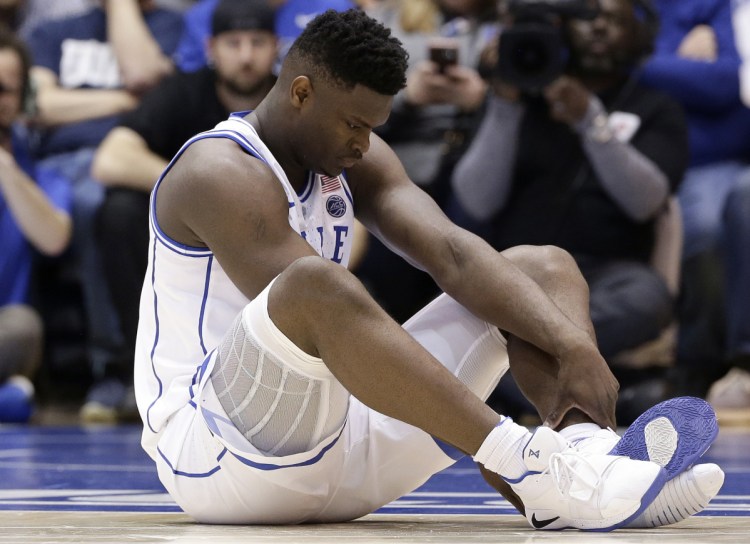The company does damage control after Zion Williamson’s shoe rips in a key game.
Very little sidetracks the sports apparel machine that is Nike, but the sight of one of its shoes disintegrating as a rising basketball superstar fell to the floor clutching his knee appears to have done it, sending the company’s stock down in trading Thursday.
At the closing bell, the apparel and fashion giant’s stock was down 1.07 percent, trading at $83.93 per share, less than a dollar off Wednesday’s closing price of $84.84.
The slide comes after Duke’s Zion Williamson injured himself as his Nike PG 2.5 shoe burst open during the Blue Devils’ prime-time game Wednesday night against North Carolina. Williamson drove right and tried to spin back left, planting his left foot hard into the floor at Cameron Indoor Stadium. But the cloth side of the shoe ripped clean away from the foam sole and Williamson, a surefire top NBA draft choice, slid to the floor clutching his right knee.
Duke coach Mike Krzyzewski called the injury a “minor knee sprain” and said the joint was “stable.” But Williamson’s availability for the rest of the season is unclear. The incident led some analysts to call for Williamson to sit out the remainder of the season even if his knee is healthy to protect his draft stock.
The repercussions for Nike also were immediate, if not severe. That was better than the dire prediction from Sonny Vaccaro, a veteran shoe executive, who said Wednesday night (via Yahoo’s Pete Thamel) that video of the moment was “already all over the world while we’re still watching the game he got hurt in. They’re going to show it until we die.”
Investors’ punishment, though, was limited. Nike’s main competitors finished the trading day with mixed results. Adidas closed down 0.14 percent. Puma and Under Armour were up 1.7 percent and 0.7 percent, respectively.
“It’s an isolated incident right now,” Brian Yarbrough, consumer research analyst at financial services firm Edward Jones, said in a phone interview. “I think it does very little to the brand. It’s unfortunate that his knee got hurt, but I think it’s pretty minuscule in the grand scheme of things. This is one product, it’s one shoe line, and there are thousands of others. You think about the number of hours people play in these shoes, and this is pretty insignificant.”
Nike moved swiftly Wednesday night to promise an investigation into just what caused Williamson’s shoe to come apart during one of the most highly anticipated college basketball games of the season and on ESPN’s national telecast to boot. Among those in attendance in Durham, North Carolina, was former President Barack Obama, who was captured on video declaring, “His shoe broke.”
“We are obviously concerned and want to wish Zion a speedy recovery,” Nike said in a statement. “The quality and performance of our products are of utmost importance. While this is an isolated occurrence, we are working to identify the issue.”
The basketball shoe industry’s reputation of developing new materials, plus a history of marketing those products, is one of the main reasons for investors’ relative confidence, equity research firm Oppenheimer advised investors in a notice provided to The Washington Post.
“At this juncture, we are optimistic that while negative headlines might weigh upon [Nike] shares for a bit, any lasting damage to the company and its shares will prove minimal,” the firm wrote. “[Nike] is renowned for producing some of the best athletic footwear and apparel in the industry and outfitting successfully many of the world’s pre-eminent athletes. The extent of the relationship between any injury to Williamson and the Nike shoes that he was wearing is not yet known.
“We cannot recall any major prior instances of [Nike] products malfunctioning. Nike senior management has a history of acting masterfully at always protecting and enhancing the company’s brand image with core customers, even through moments of pronounced consternation.” Footwear experts said Thursday the shoe’s rupture may have actually saved Williamson from a more significant injury. A top-tier athlete exerts close to five times his or her body weight when making a sudden change in direction, said Kevin Ford, a professor of biomechanics at High Point University who studies high-performance athletic equipment.
Had the shoe not have given way for Williamson’s foot, Ford said, some 1,500 pounds of force would have concentrated on his knee.
“When you look at season-ending [knee ligament] injuries, there’s usually a really sharp deceleration and there’s no place for those forces to go,” Ford said.
Basketball shoes are engineered, he said, to provide enough friction to allow players to stop quickly and change direction, and to distribute the corresponding forces across the lower body. But in the thousands of tests Ford and his research team have conducted on all manner of athletic shoes, none of them ripped like the 6-foot-7, 285-pound Williamson’s.
“Shoes have to be designed really well, and they are,” Ford said. “We’ve studied thousands of movements from athletes in all types of different shoes and never had that happen.”
The NBA late Thursday officially submitted a proposal to the National Basketball Players Association to lower the league’s draft age to 18 from 19, according to USA Today. Had the proposal been in effect before this season, it would have allowed Williamson to enter the NBA directly from high school rather than making him the latest in a line of “one and done” players who spend a single year in college to fulfill the age requirement.
NBA Commissioner Adam Silver has said he wants the league to be rid of the age limit by 2022, so teams can have time to adjust and scout younger players. The league in 2020 will begin offering elite post-high school prospects “select contracts” worth $125,000 to play a single season in the developmental G League rather than play college basketball.
Send questions/comments to the editors.



Comments are no longer available on this story